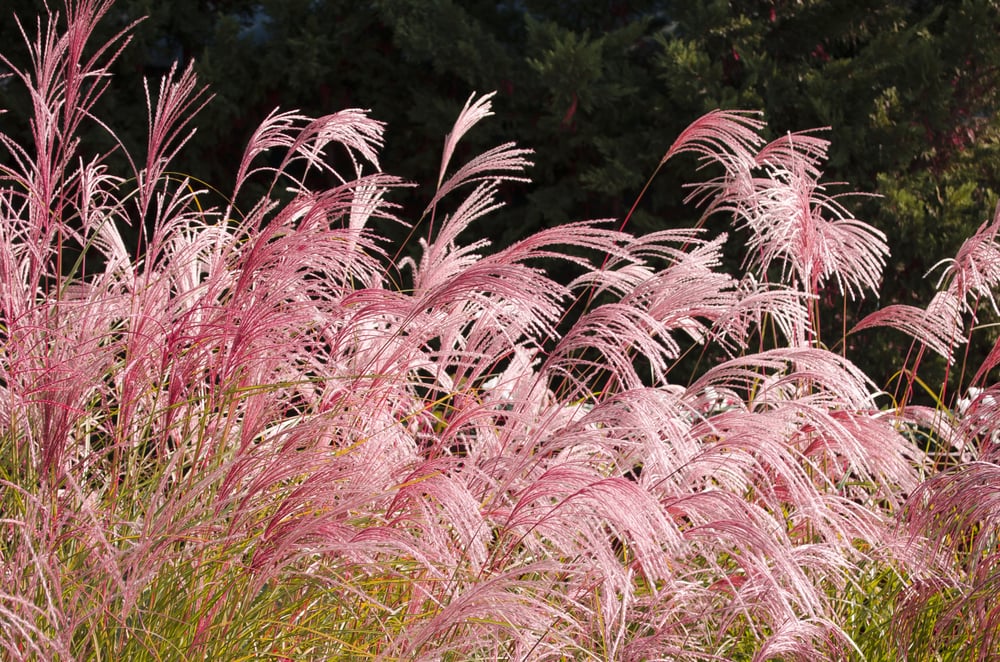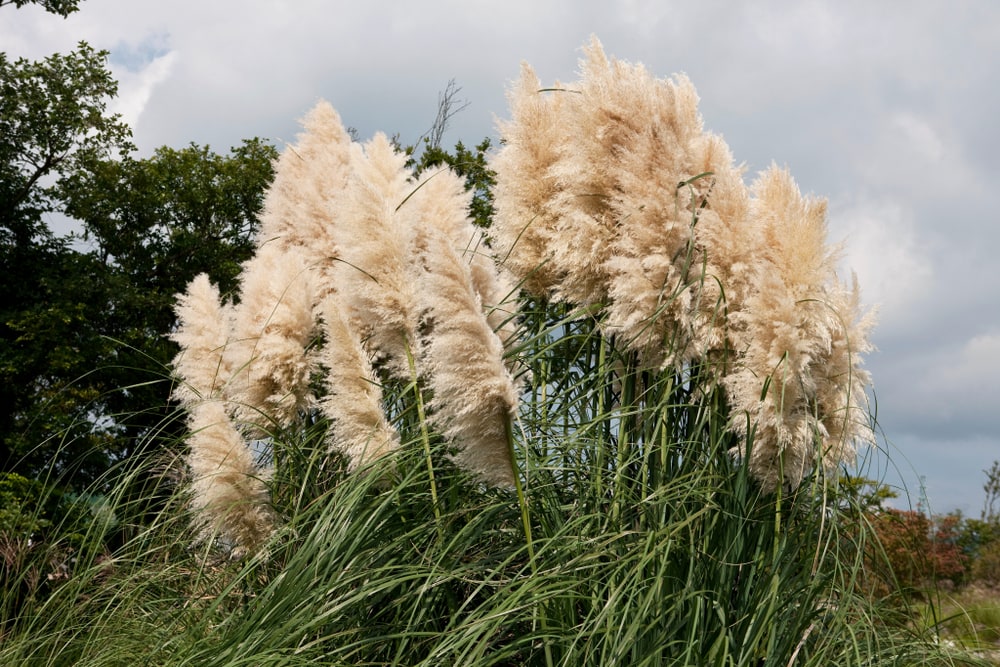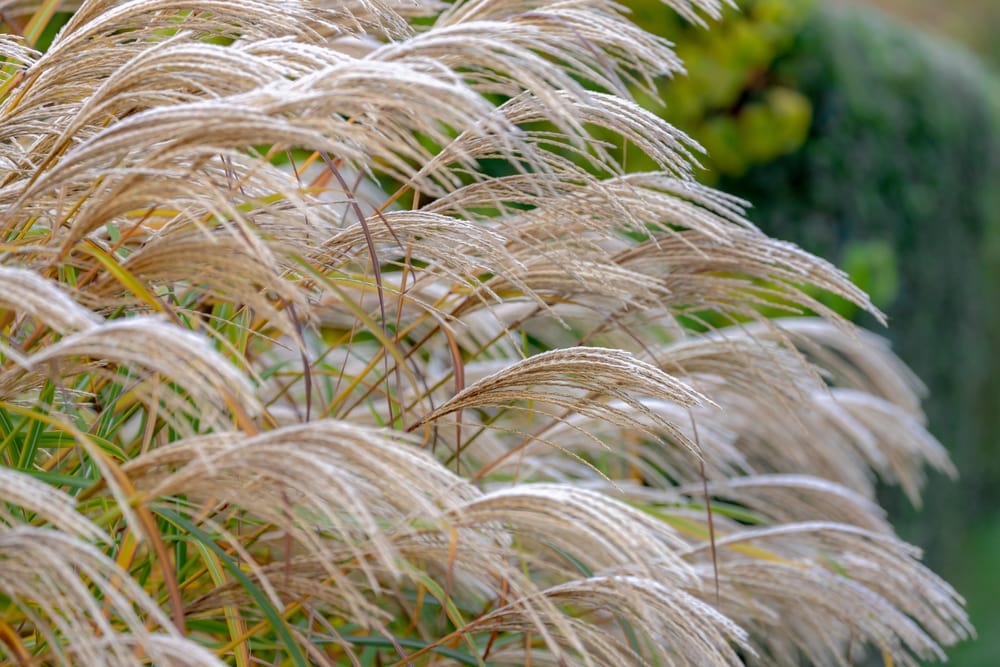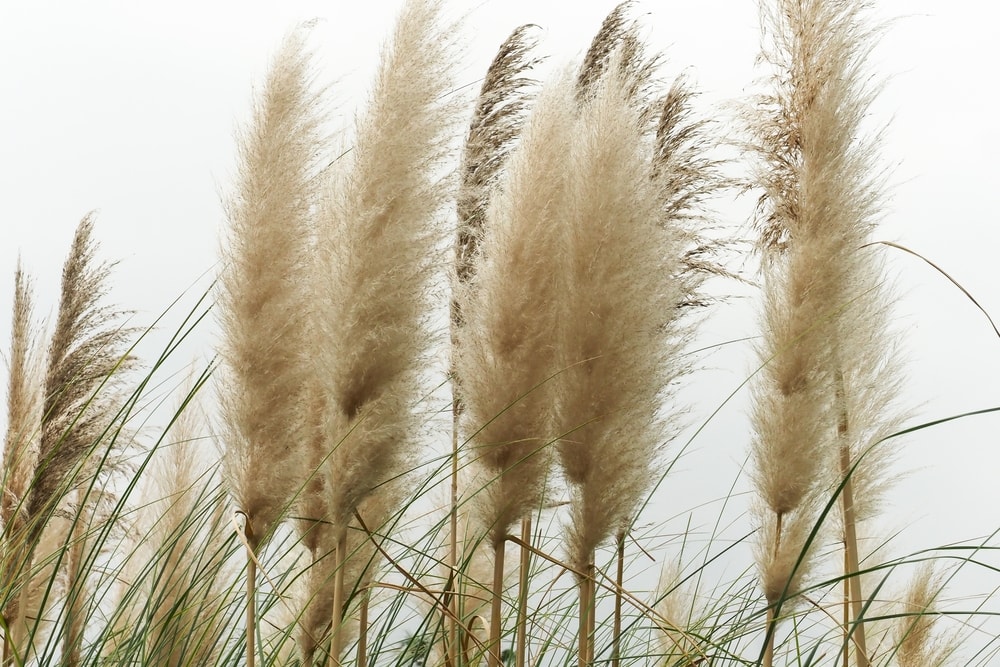12 Different Types of Pampas Grass (With Pictures)
-

- Last updated:

Native to the Pampas region of South America (hence the name), this perennial grass is quite resilient and very easy to grow. It goes dormant during the cold winter days and comes back every spring, with the flowers taking a year or two to develop. Lush, tall, and non-toxic to humans and pets, pampas is perfect as ornamental grass in any landscape.
Today, we’ll introduce you to the 12 most popular types that grow in the US. While it is, indeed, very tough and requires little maintenance, it’s still important to know which species to pick. So, check out the pictures, detailed metrics, and short descriptions to find the perfect pampas grass for your backyard garden!
The 12 Different Types of Pampas Grass
1. Gold Band

| Botanical Name | Aureolineata |
| Soil | Well-drained, fertile, sandy (pH 6.5–7.5) |
| Sun | Full sun |
| Hardiness Zone | 8a–10b |
| In Bloom | Late summer through early fall |
If you’re in the market for a relatively slow-growing pampas grass, Aureolineata could be the right pick. It’s not particularly tall, either (only reaches 5–6 feet in height) but looks great in classic backyard gardens. This is a late bloomer, by the way, and blossoms in August and lasts through early September. When fully grown, it develops thin, sleek leaves with yellow stripes.
As for the flowers, they can also be yellow/golden, but they’re mostly white. Plant this grass in well-drained, fertile, and neutral soil and make sure it gets enough sun (ideally, 6–8 hours a day). Now, this pampas species is quite resilient and erect, but it won’t survive in a cold climate. So, you might want to plant it in containers and move it indoors during winter.
2. Pink Pampas Grass

| Botanical Name | Rendatleri/Rosea |
| Soil | Well-drained, loamy, rich (pH 6.0–7.0) |
| Sun | Full sun/partial shade |
| Hardiness Zone | 7–11 |
| In Bloom | Mid-summer through fall |
Tired of generic colors in the garden? Then why don’t you try growing the pink pampas grass? It thrives in well-drained, rich, and loamy soil and will grow both in partial shade and full sun. Just like the previous species, it appreciates warmer climates and fades in hardiness zones below 7. Late June or early July is when it blooms. Rosea is a fast grower and will cover your garden in pink in no time.
The color is pretty bright, too, and has a distinctive hue that will catch your eye from afar. On average, it reaches 7–8 feet in height and lasts through most of the fall.
3. Purple Pampas Grass

| Botanical Name | Cortaderia jubata |
| Soil | Well-drained, sandy (pH 6.5–7.5) |
| Sun | Full sun/partial shade |
| Hardiness Zone | 6–10 |
| In Bloom | Mid-summer to late fall |
Here, we have another bright and colorful species that instantly grabs attention. It is also quite tall (20–22 feet), which puts it on the list of the tallest ornamental grasses. Like most pampas types, the purple one blooms in July and lasts until late fall. It prefers exposure to full sun but has no problem growing in partial shade.
The soil should be sandy, clay, and, most importantly, well-drained. Do keep in mind, though, that this is an extremely invasive grass. As long as you plant it in a 6–10 hardiness zone, it will thrive very quickly, given it gets moderate watering at least once a week.
4. Silver Comet

| Botanical Name | Cortaderia selloana |
| Soil | Well-drained, sandy, clay (pH 6.0–6.5) |
| Sun | Full sun |
| Hardiness Zone | 8a–10b |
| In Bloom | Early summer to mid-fall |
Also known as the white pampas grass, the Silver Comet blooms in early June and lasts until late October. It’s not a big fan of cold climates and will only flourish in 8a–10b zones. Besides, you’ll need to make sure it gets enough sun during the day; otherwise, it will grow slowly or wither. Now, in contrast to most plants that are famous for their flowers, the white pampas captivate with their stunning leaves.
Moreover, many gardeners like to cut the flower plumes to put the focus on the leaves.
5. Silver Stripe

| Botanical Name | Albolineata |
| Soil | Well-drained, fertile, loamy (pH 6.0–7.0) |
| Sun | Full sun |
| Hardiness Zone | 6–10 |
| In Bloom | Mid-summer to early winter |
The Silver Stripe is another variation of the white pampas, but it’s got a distinctive silver hue that makes it stand out in any landscape. In many ways, it resembles the Gold Band. We’re talking about the height and the overall shape of the grass. The panicle of flowers is mostly white yet has inclusions of silver which, again, sets it aside from all the other grass types.
Gardeners looking for the golden middle between the Silver Comet and the Gold Band will, most likely, appreciate the Silver Stripe. It blooms in late June or early July but survives through mid-December. It’s hardy to zones 6–10 and is best to be planted in a fertile, loamy soil.
6. Sunningdale Silver

| Botanical Name | Cortaderia selloana |
| Soil | Well-drained, fertile (pH 5.5–6.5) |
| Sun | Full sun/partial sun |
| Hardiness Zone | 7a–10b |
| In Bloom | Late June through fall |
Not tired of silver pampas grass yet? Then let’s take a quick look at the Sunningdale Silver. This time around, it’s the flowers that are silver and they look magnificent on stems that reach 10–12 feet in height. Unlike most pampas grass types, this one isn’t at all affected by rain, thanks to how sparse the panicles are. But the Sunningdale Silver is a very aggressive species.
To oppose its invasive nature, plant the seeds 5–6 feet apart from each other. Do that and you’ll see them bloom in mid-summer, even if the grass is only exposed to partial shade.
7. Silver Fountain

| Botanical Name | Cortaderia selloana |
| Soil | Well-drained, moist, fertile (pH 6.0–6.5) |
| Sun | Full sun/partial sun |
| Hardiness Zone | 7–10 |
| In Bloom | July through mid-November |
And what is this pampas grass type all about? Why should you pick it for your garden? Well, it’s not that different on the “technical” front: well-drained, fertile soil, full/partial sun, and hardy to zones 7–10. And it blooms in July and lives on through late fall. It’s the big, silver flower heads that make it a crowd-pleaser. The leaves, in turn, are densely packed and bright green.
Water it twice a week during the hot summer days and it will grow rapidly. This isn’t very tall grass, however. It usually reaches 4–5 inches in height, which means it won’t block the view completely.
8. Dwarf Pampas Grass

| Botanical Name | Pumila |
| Soil | Well-drained, sandy, loamy, clay (pH 6.0–7.0) |
| Sun | Full sun |
| Hardiness Zone | 6b–10 |
| In Bloom | Mid-summer through fall |
As the name suggests, this pampas grass isn’t particularly tall: it only reaches 4–5 feet in height. Yet, it does compensate for that with the diversity of colors. The flowers are quite showy and can be yellow, white, or ivory. The plumes are nice and big and look perfect along backyard fences or walls. They don’t produce seeds, by the way, and that means this isn’t the most invasive grass out there.
Water requirements are low, but it is recommended to expose the Dwarf Pampas to full sun. It is mildly cold-tolerant (zones 6b–10) and grows best in sandy, clay, and loamy soil.
9. Sun Stripe

| Botanical Name | Monvin |
| Soil | Well-drained, sandy, clay (pH 5.5–6.5) |
| Sun | Full sun |
| Hardiness Zone | 7–10 |
| In Bloom | Early June through November |
Also known as “Monvin”, the Sun Stripe is an excellent choice as a border plant. It can create pathway transitions, divide different parts of the garden, separate your yard from the neighbors, and more. The Sun Stripe blooms in early summer and survives through late November. It fully develops in the fall, growing 7-feet-tall plumes with beautiful flowers. Full sun and well-drained soil—that’s all you’ll need to cultivate this grass.
10. Hardy Pampas Grass

| Botanical Name | Saccharum Ravennae |
| Soil | Well-drained, rich, loamy (pH 6.0–7.5) |
| Sun | Full sun |
| Hardiness Zone | 5b–9a |
| In Bloom | Summer through early winter |
Technically, this isn’t pampas grass in its pure form, but it’s still recognized as such because of the similarities. Now, it grows rather tall (up to 12 feet) and produces flowers that are purple in early summer and turn white/silver as winter approaches. Next, the leaves have a white stripe that turns red during cold days. Speaking of winter, this invasive grass can survive through December.
Just make sure the soil isn’t moist and that it gets enough exposure to the sun (at least 5–6 hours).
11. Patagonia Pampas Grass

| Botanical Name | Patagonia |
| Soil | Well-drained, sandy, clay (pH 5.5–6.5) |
| Sun | Full sun/partial shade |
| Hardiness Zone | 6–10 |
| In Bloom | Late summer to mid-winter |
Green leaves with a bluish hue, silver/white flowers, and 5–6 feet of height—that’s the Patagonia grass in a nutshell for you. If you’ve just planted the seeds and want them to grow as quickly as possible, see that the soil is well-drained and sandy. Don’t fertilize it much, though, as that can cause more harm than good. Full exposure to the sun is, as always, preferred, but partial shade is also fine.
Patagonia blooms in August, which is a bit late for ornamental grass. However, it does stick around until late December/early January.
12. Splendid Star

| Botanical Name | Dwarf Golden Pampas |
| Soil | Well-drained, fertile (pH 6.0–7.0) |
| Sun | Full sun/partial sun |
| Hardiness Zone | 7–11 |
| In Bloom | Mid-summer to early winter |
What’s so splendid about this pampas grass type, you might ask? First, this is a hardy plant: it can grow both in an outdoor garden and in containers. Second, it’s a great choice for borders, thanks to its resilient nature. It survives through early winter and doesn’t require lots of sunlight to thrive. The soil needs to be well-drained and fertile, but it’s safe to say that any soil will do, as long as it’s not moist.
But that’s not even its biggest appeal. What makes the Splendid Start so popular is the color of the leaves. The golden streaks and the beautiful white panicles are a sight for sore eyes.
 How to Control Pampas Grass
How to Control Pampas Grass
The best thing about this grass—it requires minimal maintenance. As long as you water it once a week to prevent drought from taking over, it will grow and thrive. With that said, pampas need to be trimmed at least once a year. We recommend doing this in early spring, before the blooming season, or in mid/late winter. Cut it to 2–3 feet for the best result. When pruning, don’t forget to put protective gloves on.
Pampas grass is quite sharp and can cut you. So, long sleeves and eye goggles are also in order. Next, be very careful when growing pampas in your garden, because it is an invasive plant and can quickly take over the landscape and crowd out your favorite plants. It is, after all, classified as a Class C noxious weed! Cutting inflorescences and pulling/grubbing seedlings have proven to be effective growth control measures.
Growing Tips and Tricks
Plenty of room: that’s the most important thing to provide for pampas grass. This is especially true if you’re planting a whole garden of it. See that there are at least 6–8 feet between the individual plants. It can grow and prosper in various soil types, yet, if you want to see steady growth, go for well-drained, mildly rich, and loamy soil. You could also add some compost, but only in little amounts—don’t overdo it!
Full sun is best (6–8 hours of it), but this grass does thrive in partial shade as well. Water it once or twice a week, depending on how hot and dry it is. Hardy to zones 6 through 11, pampas grass thrive in hot coastal areas and will flourish in any state/city with above-average temperatures. However, this grass can’t handle the cold. You should bring it indoors during the winter or just let it die/go dormant and grow back in spring.
Why Is Pampas Not Producing Flowers?
Many gardeners think that if they’re not seeing any flowers, that means the grass is taken over by a disease, but that’s not really true. The reason for this is nitrogen. Most likely, you’re planting pampas grass in fertilizer-rich soil. Well, an overabundance of nitrogen and lack of phosphorus are known to suppress the growth of certain grass types.
What you can do here is add some phosphorous-heavy compost. That will stabilize the balance of chemical elements and allow pampas flowers to “poke through”.
Final Thoughts
Pampas grass is a great choice for creating focal points, accentuating certain parts of your garden, and introducing different colors/textures into the landscape. It doesn’t require expensive fertilizer products, constant watering, or 24/7 maintenance to flourish. Just make sure to give it enough space when planting, and this fast-grower will reach 5–10 feet in no time!
If you need a cheap, resilient, and beautiful grass species, look no further! Pampas has a 10–15-year lifespan and easily handles heavy winds and drought. So, pick a species from our list, follow the recommendations on soil, sun, and watering, and enjoy! Be careful with it, though, as this grass is quite invasive!
Featured Image Credit: annie-spratt, Unsplash
Contents

 How to Control Pampas Grass
How to Control Pampas Grass